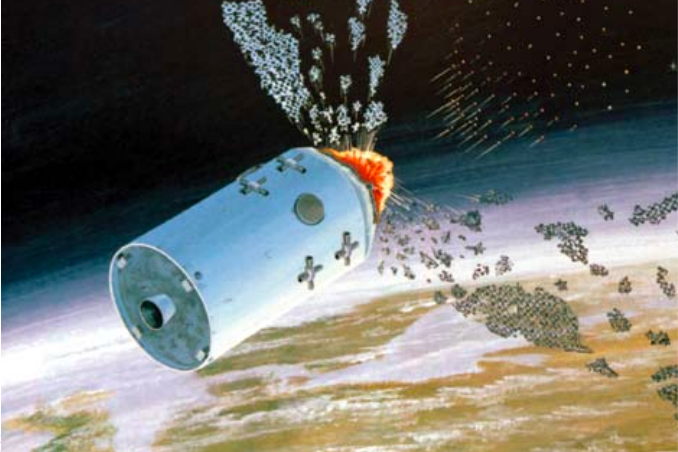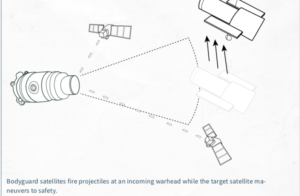
ASAT Test, artist’s rendering, National Defense University
WASHINGTON: The US must make near-term policy, technical and investment decisions about how it intends to defend space assets from growing military threats — including putting ‘active defenses’ such as lasers on satellites, says a new study by the Center for Strategic and International Studies (CSIS).
“If space is to remain a source of economic and strategic advantage, the United States must prioritize and expedite its efforts to improve space defenses. Robust space defenses make conflict in space less likely,” argues Defense Against the Dark Arts in Space: Protecting Space Systems from Counterspace Weapons.
“Many of the architectures and technologies already exist to make space systems more defendable and resilient. Senior leaders in DoD and Congress need to make top-level decisions about which types of defenses to pursue and then provide sustained investments to fund these capabilities to fruition,” the study concludes.
Despite its cheeky Harry Potter theme, the first-of-its-kind study takes a serious look at the technologies available to protect and defend US satellites, and articulates the policy issues that need to be addressed in using them.
The report reviews the growing threats in space, especially from Russia and China — both of which have tested anti-satellite (ASAT) technologies in recent years. “Russia and China are arguably making advances in counterspace weapons faster than the United States is improving its defenses against these threats,” the study argues.
It also includes a detailed chart matching threats to potentially useful responses, based in part a series of expert workshops to play out potential threat and response scenarios.
“If space threats are the dark arts, then what this report talks about is defending against the dark arts,” said Todd Harrison, director of CSIS’s Aerospace Security Project.
Harrison (Gryffindor), Kaitlyn Johnson (Slytherin) and Makena Young (Hufflepuff), in a pre-release discussion with reporters yesterday, stressed that the primary goal of the 60-page report is to bring this long-overdue debate into the public domain, using unclassified sources so that stakeholders — from military leaders to Congress to allies to academics — can discuss potential choices.
“This issue of classification and the challenge it presents to public discussion is … part of the reason why we wrote this report. There’s nothing in the public domain like this,” Johnson said.
Harrison stressed that it is necessary to “open up the public dialogue, and give non-space experts and space experts a like a tool, an ability, to have that discussion in open forums, without having to rely on all the classified information and studies and stuff that [DoD and the Space Force are] doing behind the scenes — to be able to talk about these things more publicly, and help emphasize to folks that space is a contested domain just like all the other domains. You just have to think about and strategize about how you’re going to defend yourself.”
Indeed, senior military leaders — including Vice Chairman of the Joint Chiefs of Staff Gen. John Hyten (who has long been one of the top military thinkers on space), Chief of Space Operations Gen. Jay Raymond, and Space Command head Gen. James Dickinson have been expressing frustration about the over-classification of all things space.
Further, the House Armed Services strategic forces subcommittee held a Feb. 23 hearing specifically to highlight the growing threats from Chinese and Russian counterspace (and nuclear modernization) efforts — with both Democrats and Republicans lamenting the inability to speak freely about the issues to inform the American public.
However, Harrison said, changing that culture of secrecy — which is most deeply ingrained in the Intelligence Community and the National Reconnaissance Office (NRO) — isn’t going to be easy.
“It is going to take a lot of time, and it’s going to take senior level involvement higher than four-star generals, to really break the logjam and bring more rationalization into what is classified and what is not classified,” he said.
This is despite the fact that much of the debate can be, and is being, discussed outside the US military. For example, he said, France has been openly talking about arming its future satellites with lasers.
“You’ll see a lot of this is based just on physics, … simple logic and things that are being discussed in the open, sometimes in the commercial sector, sometimes by foreign governments,” Harrison said with obvious frustration. “And a lot of times, I think, in the military and Intel Community they wrap themselves around the axle trying to classify things, and they end up classifying obvious stuff, things like the sky is blue,” he said.
The CSIS study makes a series of general recommendations:
- Invest in improved space domain awareness capabilities, including more space-based sensors, better integration with commercial and friendly foreign government systems, and use artificial intelligence to analyze data and form a better understanding of capabilities and intentions.
- Place more emphasis on developing improved indications and warnings for space that give decision-makers more time and information to tailor potential defensive responses to the specific circumstances of a conflict.
- New space architectures are needed that use a combination of distribution, proliferation and diversification of orbits. These do not necessarily need to replace legacy architectures but can be used to supplement and diversify capabilities that already exist.
- Non-kinetic active defenses, such as onboard jamming and lasing systems, are needed to thwart kinetic attacks against high-value satellites. A physical seizure capability should be explored that could double as an inspector and on-orbit servicing satellite.
- New options should be considered to improve DoD’s integration with commercial space operators and better leverage existing space systems for national security purposes. For example, DoD could create a program like the Civil Reserve Air Fleet (CRAF) with commercial space operators and use that program to incentivize investments in better passive defenses for commercial space systems
- A better understanding is needed of the operational, political, and strategic risks involved in the use of stealth, maneuver, rapid deployment, and reconstitution before committing significant resources to these passive defenses.
- Further analysis and gaming are needed to explore gray zone competition in space and when it is advantageous (or not) to do nothing in response to an attack or threat of attack.
The recommendation that DoD pursue ‘active defenses’, including lasers on board satellites, is perhaps the most controversial issue raised by CSIS. As Breaking D readers know, the line between active defense and offensive operations is far from clear and has been the subject of debate among military space experts both in the US and overseas for decades.

A “bodyguard” satellite is an example of “active defenses” against space-based threats, CSIS image
“Active defenses are things that could be used for offensive purposes as well,” conceded Harrison. On the other hand, he argued, while offensive actions could also be considered as a form of defense, there are other considerations that may make doing so a less attractive option.
“I think when you look at scenarios in which those things would be used, if you look at the policy implications of some of them and how they would be viewed by other countries and what their responses could be, you start to then realize: oh, maybe some of these other defenses are better options,” he said. “But we just want to put it out there, for folks to be able to make that judgment for themselves.”
Further, the study is careful to stress that any active defenses should be non-kinetic.
“We don’t want to be putting kinetic defenses on our satellites, because that runs the risk of creating more space debris. Also, it could be viewed by an adversary as some sort of an anti-satellite weapon itself, an offensive weapon,” he said.
The CSIS caution on debris-creating weapons echoes sentiments voiced by Raymond and other leaders over the past several years. Raymond reiterated his concern about debris creating ASATs yesterday in his fireside chat with popular astrophysicist Neil deGrasse Tyson during the Air Force Association’s annual winter meeting.
“Why does anyone want to completely destroy a satellite if it contaminates the sandbox for everybody?” deGrasse Tyson asked.
Raymond responded: “It’s irresponsible behavior. We don’t want that to happen.”
While Harrison said that there isn’t a hierarchy to the recommendations, he and the other authors agreed the most urgent need is improved space domain awareness. Increasing space domain awareness is at the forefront, because if we can’t understand what’s going on in space, how can we possibly make informed decisions to protect our space assets?” said Johnson.
The CSIS authors were cautious in characterizing how far they thought the internal DoD debate about these issues has progressed — including the issue of what norms of behavior the US itself wants to see others adhere to and, perhaps more importantly, is itself willing to uphold.
“If you look at some of the strategy and doctrine documents that have been coming out, and the Commander’s Vision — things like that that have been coming out of the Space Force and Space Command — it does give some indication that they are starting to think through some of these issues; that they are starting to define differences between active defenses and passive defenses,” said Harrison. “So some of the terminology that we use in the report is making it into some of these documents, but it is still not clear the extent of how much they’re thinking through these issues on a more granular technical and policy level, behind the scenes.”
And that job — thinking through the issues in depth — is squarely on Raymond’s shoulders, Harrison added. “This is his job. This is no one else’s job,” he said bluntly.
China’s new H-20 stealth bomber ‘not really’ a concern for Pentagon, says intel official
“The thing with the H-20 is when you actually look at the system design, it’s probably nowhere near as good as US LO [low observable] platforms, particularly more advanced ones that we have coming down,” said a DoD intelligence official.


























